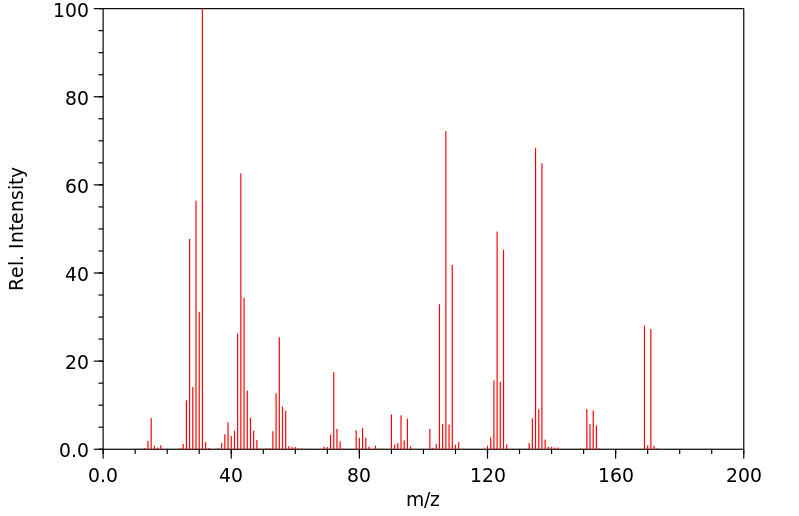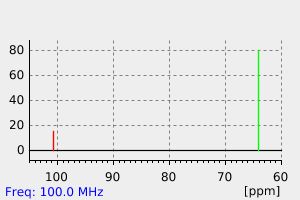2-溴-2-硝基-1,3-丙二醇 | 52-51-7
分子结构分类
-
物化性质
-
计算性质
-
ADMET
-
安全信息
-
SDS
-
制备方法与用途
-
上下游信息
-
文献信息
-
表征谱图
-
同类化合物
-
相关功能分类
-
相关结构分类
物化性质
-
熔点:130-133 °C(lit.)
-
沸点:358.0±42.0 °C(Predicted)
-
密度:2.0002 (rough estimate)
-
闪点:167°C
-
溶解度:H2O:可溶,100mg/mL,透明,无色至淡黄色
-
LogP:1.150 (est)
-
物理描述:2-bromo-2-nitropropane-1,3-diol appears as white crystals. Ignite easily and burn readily. May detonate under strong shock. Decomposes when heated, evolving toxic gases. Toxic by skin absorption, inhalation or ingestion.
-
颜色/状态:White crystalline powder
-
气味:Odorless
-
蒸汽压力:1.26X10-5 mm Hg at 20 °C
-
稳定性/保质期:
-
分解:The substance decomposes on heating or on burning producing toxic and corrosive fumes, including hydrogen bromide and nitrogen oxides.
计算性质
-
辛醇/水分配系数(LogP):-0.6
-
重原子数:9
-
可旋转键数:2
-
环数:0.0
-
sp3杂化的碳原子比例:1.0
-
拓扑面积:86.3
-
氢给体数:2
-
氢受体数:4
ADMET
安全信息
-
TSCA:Yes
-
危险等级:4.1
-
危险品标志:Xn
-
安全说明:S26,S37/39,S61
-
危险类别码:R21/22,R50,R41,R37/38
-
WGK Germany:2
-
海关编码:2905590030
-
危险品运输编号:UN 3241 4.1/PG 3
-
RTECS号:TY3385000
-
包装等级:III
-
危险类别:4.1
-
储存条件:本品应密封保存于阴凉干燥处。
SDS
模块 1. 化学品
1.1 产品标识符
: 2-溴-2-硝基-1,3-丙二醇
产品名称
1.2 鉴别的其他方法
Bronopol
1.3 有关的确定了的物质或混合物的用途和建议不适合的用途
仅用于研发。不作为药品、家庭或其它用途。
模块 2. 危险性概述
2.1 GHS-分类
急性毒性, 经口 (类别 3)
急性毒性, 吸入 (类别 5)
急性毒性, 经皮 (类别 4)
皮肤刺激 (类别 2)
严重眼睛损伤 (类别 1)
特异性靶器官系统毒性(一次接触) (类别 3)
急性水生毒性 (类别 1)
2.2 GHS 标记要素,包括预防性的陈述
象形图
警示词 危险
危险申明
H301 吞咽会中毒
H312 皮肤接触有害。
H315 造成皮肤刺激。
H318 造成严重眼损伤。
H333 吸入可能有害。
H335 可能引起呼吸道刺激。
H400 对水生生物毒性极大。
警告申明
预防措施
P261 避免吸入粉尘/烟/气体/烟雾/蒸气/喷雾.
P264 操作后彻底清洁皮肤。
P270 使用本产品时不要进食、饮水或吸烟。
P271 只能在室外或通风良好之处使用。
P273 避免释放到环境中。
P280 穿戴防护手套/ 眼保护罩/ 面部保护罩。
事故响应
P301 + P310 如果吞下去了: 立即呼救解毒中心或医生。
P302 + P352 如果皮肤接触:用大量肥皂和水清洗。
P304 + P340 如吸入: 将患者移到新鲜空气处休息,并保持呼吸舒畅的姿势。
P305 + P351 + P338 如与眼睛接触,用水缓慢温和地冲洗几分钟。如戴隐形眼镜并可方便地取
出,取出隐形眼镜,然后继续冲洗.
P310 立即呼叫中毒控制中心或医生.
P322 具体处置(见本标签上提供的急救指导)。
P330 漱口。
P332 + P313 如觉皮肤刺激:求医/就诊。
P362 脱掉沾污的衣服,清洗后方可再用。
P391 收集溢出物。
安全储存
P403 + P233 存放于通风良的地方。 保持容器密闭。
P405 存放处须加锁。
废弃处置
P501 将内容物/ 容器处理到得到批准的废物处理厂。
2.3 其它危害物 - 无
模块 3. 成分/组成信息
3.1 物 质
: Bronopol
别名
: C3H6NO4Br
分子式
: 199.99 g/MOl
分子量
组分 浓度或浓度范围
2-BroMO-2-nitroproPANe-1,3-diol
<=100%
化学文摘登记号(CAS 52-51-7
No.) 200-143-0
EC-编号 603-085-00-8
索引编号
模块 4. 急救措施
4.1 必要的急救措施描述
一般的建议
请教医生。 向到现场的医生出示此安全技术说明书。
吸入
如果吸入,请将患者移到新鲜空气处。 如呼吸停止,进行人工呼吸。 请教医生。
皮肤接触
用肥皂和大量的水冲洗。 立即将患者送往医院。 请教医生。
眼睛接触
用大量水彻底冲洗至少15分钟并请教医生。
食入
切勿给失去知觉者通过口喂任何东西。 用水漱口。 请教医生。
4.2 主要症状和影响,急性和迟发效应
据我们所知,此化学,物理和毒性性质尚未经完整的研究。
4.3 及时的医疗处理和所需的特殊处理的说明和指示
无数据资料
模块 5. 消防措施
5.1 灭火介质
灭火方法及灭火剂
用水雾,抗乙醇泡沫,干粉或二氧化碳灭火。
5.2 源于此物质或混合物的特别的危害
碳氧化物, 氮氧化物, 溴化氢气
5.3 给消防员的建议
如必要的话,戴自给式呼吸器去救火。
5.4 进一步信息
用水喷雾冷却未打开的容器。
模块 6. 泄露应急处理
6.1 作业人员防护措施、防护装备和应急处置程序
戴呼吸罩。 避免粉尘生成。 避免吸入蒸气、烟雾或气体。 保证充分的通风。 人员疏散到安全区域。
避免吸入粉尘。
6.2 环境保护措施
如能确保安全,可采取措施防止进一步的泄漏或溢出。 不要让产品进入下水道。
一定要避免排放到周围环境中。
6.3 泄漏化学品的收容、清除方法及所使用的处置材料
扫掉和铲掉。
围堵溢出,用防电真空清洁器或湿刷子将溢出物收集起来,并放置到容器中去,根据当地规定处理(见第13部
分)。 放入合适的封闭的容器中待处理。
围堵溢出,用防电的真空清洁器或者湿刷子收起,然后装入容器,按照当地法规处理(见第13部分)。
6.4 参考其他部分
丢弃处理请参阅第13节。
模块 7. 操作处置与储存
7.1 安全操作的注意事项
避免接触皮肤和眼睛。 避免形成粉尘和气溶胶。
在有粉尘生成的地方,提供合适的排风设备。切勿靠近火源。-严禁烟火。远离热源和火源。
7.2 安全储存的条件,包括任何不兼容性
贮存在阴凉处。 使容器保持密闭,储存在干燥通风处。
7.3 特定用途
无数据资料
模块 8. 接触控制和个体防护
8.1 容许浓度
最高容许浓度
没有已知的国家规定的暴露极限。
8.2 暴露控制
适当的技术控制
避免与皮肤、眼睛和衣服接触。 休息前和操作本品后立即洗手。
个体防护设备
眼/面保护
面罩與安全眼鏡请使用经官方标准如NIOSH (美国) 或 EN 166(欧盟) 检测与批准的设备防护眼部。
皮肤保护
戴手套取 手套在使用前必须受检查。
请使用合适的方法脱除手套(不要接触手套外部表面),避免任何皮肤部位接触此产品.
使用后请将被污染过的手套根据相关法律法规和有效的实验室规章程序谨慎处理. 请清洗并吹干双手
所选择的保护手套必须符合EU的89/686/EEC规定和从它衍生出来的EN 376标准。
完全接触
物料: 丁腈橡胶
最小的层厚度 0.11 mm
溶剂渗透时间: 480 min
测试过的物质Dermatril® (KCL 740 / Z677272, 规格 M)
飞溅保护
物料: 丁腈橡胶
最小的层厚度 0.11 mm
溶剂渗透时间: 480 min
测试过的物质Dermatril® (KCL 740 / Z677272, 规格 M)
, 测试方法 EN374
如果以溶剂形式应用或与其它物质混合应用,或在不同于EN
374规定的条件下应用,请与EC批准的手套的供应商联系。
这个推荐只是建议性的,并且务必让熟悉我们客户计划使用的特定情况的工业卫生学专家评估确认才可.
这不应该解释为在提供对任何特定使用情况方法的批准.
身体保护
全套防化学试剂工作服, 防护设备的类型必须根据特定工作场所中的危险物的浓度和数量来选择。
呼吸系统防护
如危险性评测显示需要使用空气净化的防毒面具,请使用全面罩式多功能微粒防毒面具N100型(US
)或P3型(EN
143)防毒面具筒作为工程控制的候补。如果防毒面具是保护的唯一方式,则使用全面罩式送风防毒
面具。 呼吸器使用经过测试并通过政府标准如NIOSH(US)或CEN(EU)的呼吸器和零件。
模块 9. 理化特性
9.1 基本的理化特性的信息
a) 外观与性状
形状: 结晶
颜色: 浅褐色
b) 气味
无数据资料
c) 气味阈值
无数据资料
d) pH值
无数据资料
e) 熔点/凝固点
熔点/凝固点: 130 - 133 °C - lit.
f) 沸点、初沸点和沸程
无数据资料
g) 闪点
无数据资料
h) 蒸发速率
无数据资料
i) 易燃性(固体,气体)
无数据资料
j) 高的/低的燃烧性或爆炸性限度 无数据资料
k) 蒸气压
无数据资料
l) 蒸汽密度
无数据资料
m) 密度/相对密度
无数据资料
n) 水溶性
无数据资料
o) n-辛醇/水分配系数
无数据资料
p) 自燃温度
无数据资料
q) 分解温度
无数据资料
r) 粘度
无数据资料
模块 10. 稳定性和反应活性
10.1 反应性
无数据资料
10.2 稳定性
无数据资料
10.3 危险反应
无数据资料
10.4 应避免的条件
热,火焰和火花。
10.5 不相容的物质
强氧化剂, 强碱, 强还原剂
10.6 危险的分解产物
其它分解产物 - 无数据资料
模块 11. 毒理学资料
11.1 毒理学影响的信息
急性毒性
半数致死剂量 (LD50) 经口 - 大鼠 - 180 mg/kg
半数致死浓度(LC50) 吸入 - 大鼠 - 6 h - > 5,000 mg/m3
半数致死剂量 (LD50) 经皮 - 大鼠 - 1,600 mg/kg
皮肤刺激或腐蚀
皮肤 - 兔子 - 皮肤刺激
眼睛刺激或腐蚀
无数据资料
呼吸道或皮肤过敏
无数据资料
生殖细胞致突变性
无数据资料
致癌性
IARC:
此产品中没有大于或等于 0。1%含量的组分被 IARC鉴别为可能的或肯定的人类致癌物。
生殖毒性
无数据资料
特异性靶器官系统毒性(一次接触)
可能引起呼吸道刺激。
特异性靶器官系统毒性(反复接触)
无数据资料
吸入危险
无数据资料
潜在的健康影响
吸入 吸入可能有害。 引起呼吸道刺激。
摄入 误吞会中毒。
皮肤 通过皮肤吸收有害。 造成皮肤刺激。
眼睛 引起眼睛灼伤。
接触后的征兆和症状
据我们所知,此化学,物理和毒性性质尚未经完整的研究。
附加说明
化学物质毒性作用登记: TY3385000
模块 12. 生态学资料
12.1 生态毒性
对鱼类的毒性 半数致死浓度(LC50) - 虹鳟 (红鳟鱼) - 20 mg/l - 96.0 h
对水蚤和其他水生无脊 半数效应浓度(EC50) - 大型蚤 (水蚤) - 1.6 mg/l - 48 h
椎动物的毒性
12.2 持久性和降解性
无数据资料
12.3 潜在的生物累积性
无数据资料
12.4 土壤中的迁移性
无数据资料
12.5 PBT 和 vPvB的结果评价
无数据资料
12.6 其它不良影响
对水生生物毒性极大。
模块 13. 废弃处置
13.1 废物处理方法
产品
在装备有加力燃烧室和洗刷设备的化学焚烧炉内燃烧处理,特别在点燃的时候要注意,因为此物质是高度易燃
性物质 将剩余的和不可回收的溶液交给有许可证的公司处理。
受污染的容器和包装
按未用产品处置。
模块 14. 运输信息
14.1 联合国危险货物编号
欧洲陆运危规: 3241 国际海运危规: 3241 国际空运危规: 3241
14.2 联合国运输名称
欧洲陆运危规: 2-BROMO-2-NITROPROPANE-1,3-DIOL
国际海运危规: 2-BROMO-2-NITROPROPANE-1,3-DIOL
国际空运危规: 2-BroMO-2-nitroproPANe-1,3-diol
特殊措施: “Keep away from HEAt” label required.
14.3 运输危险类别
欧洲陆运危规: 4.1 国际海运危规: 4.1 国际空运危规: 4.1 (HEAT)
14.4 包裹组
欧洲陆运危规: III 国际海运危规: III 国际空运危规: III
14.5 环境危险
欧洲陆运危规: 是 国际海运危规 国际空运危规: 否
海洋污染物(是/否): 是
14.6 对使用者的特别提醒
无数据资料
模块 15 - 法规信息
N/A
模块16 - 其他信息
N/A
制备方法与用途
布罗波尔(Bromopropyl),又称溴代二乙醇胺或2-溴-2-硝基丙烷-1,3-二醇,是一种有机化合物和广谱杀菌剂。它具有多种应用领域,主要包括农业、化妆品和个人护理产品、工业水处理、医药以及农药等领域。
布罗波尔的生产方法主要有两种:
布罗波尔的主要用途如下:
- 农业:作为杀菌剂用于防治多种植物病原细菌。例如对棉花种子的处理可预防棉花角斑病菌引起的黑臂病和雕枯病。
- 化妆品和个人护理产品:用作防腐剂,应用于香波、香脂及霜剂等加工过程中,在化妆品中的添加浓度为0.01%-0.02%。也可用于洗涤剂和织物处理剂中。
- 工业应用:用作工业循环水的杀菌、防霉和防腐灭藻剂;还可用作造纸厂纸浆和循环冷却水系统的粘泥控制剂等。
布罗波尔的物理化学性质包括为无色或黄褐色结晶,熔点130℃,蒸气压较低(1.68×10^-3 Pa),溶于丙酮、2-甲氧基乙醇及甲苯等多种有机溶剂,在水中溶解度较高。
然而值得注意的是,布罗波尔属于高毒级别物质。尽管在特定条件下具有良好的生物活性和广泛的杀菌谱,但在生产和使用时需要严格遵守安全操作规程以避免对人体健康产生不良影响。应妥善储存于通风、低温干燥的库房中,并与食品原料分开存放。
上下游信息
-
上游原料
中文名称 英文名称 CAS号 化学式 分子量 2-溴-2-硝基乙醇 2-Brom-2-nitro-aethanol 5437-60-5 C2H4BrNO3 169.963 2-硝基-1,3-丙烷二醇 2-nitropropane-1,3-diol 1794-90-7 C3H7NO4 121.093 -
下游产品
中文名称 英文名称 CAS号 化学式 分子量 5-溴-5-硝基-1,3-二恶烷 bronidox 30007-47-7 C4H6BrNO4 212.0 2-溴-2-硝基乙醇 2-Brom-2-nitro-aethanol 5437-60-5 C2H4BrNO3 169.963 2-硝基-1,3-丙烷二醇 2-nitropropane-1,3-diol 1794-90-7 C3H7NO4 121.093
反应信息
-
作为反应物:描述:2-溴-2-硝基-1,3-丙二醇 在 trifluoroborane diethyl ether 、 碳酸氢钠 作用下, 以 正己烷 、 丙酮 为溶剂, 以40%的产率得到5-bromo-2,2-dimethyl-5-nitro-1,3-dioxane参考文献:名称:5-Bromo-5-nitro-2-alkylsubstituted-1,3-dioxane摘要:5-溴-5-硝基-2-烷基取代-1,3-二噁烷类化合物,例如5-溴-2-甲基-5-硝基-1,3-二噁烷,是一种新型抗菌和抗真菌药物。公开号:US04025533A1
-
作为产物:参考文献:名称:一种溴硝醇的制备方法摘要:本发明公开了一种溴硝醇的制备方法,其特征在于,包括如下制备步骤:将化合物1A与硝化试剂进行反应,得到化合物2A;将上述的化合物2A与水进行水解反应,再与溴化试剂进行反应,即得溴硝醇粗品,经过纯化后,得到溴硝醇精品。本发明采用价格较低的试剂作为起始原料,经过硝化、水解、溴化等反应,得到最终产品,每步的反应条件温和,得到的溴硝醇收率高,能够大幅降低成本。公开号:CN112679359B
-
作为试剂:描述:参考文献:名称:甲醇溶剂化对硫醇盐与2-取代-2-硝基丙烷的亲核反应的影响摘要:甲醇溶剂化可防止Me 2 C(X)NO 2与硫醇盐反应中的S RN 1取代,并促进另一种氧化还原反应生成二硫化物和亚硝酸盐。DOI:10.1016/s0040-4039(00)99911-8
文献信息
-
Intermolecular nitroso Diels–Alder cycloaddition of α-acetoxynitroso derivatives in aqueous medium作者:Géraldine Calvet、Régis Guillot、Nicolas Blanchard、Cyrille KouklovskyDOI:10.1039/b513397a日期:——The Diels-Alder cycloadditions of the alpha-acetoxynitroso dienophile in water are reported. The rapid and high yielding synthesis of structurally diverse 3,6-dihydro-1,2-oxazines complements the straightforward elaboration of aminoalcohols obtained from the alpha-acetoxynitroso derivative in anhydrous medium. A rationale for this solvent-dependent product distribution is proposed.
-
Direct and Efficient Preparation of<i>gem</i>-Chloronitro Compounds or Nitro Compounds from<i>gem</i>-Bromonitro Compounds作者:A. Amrollah-Madjdabadi、R. Beugelmans、A. LechevallierDOI:10.1055/s-1986-31791日期:——Sodiumethanethiolate in methanol is an efficient reducing agent for gem-bromonitro compounds; treatment of the resultant nitronates with a protic acid or with N-chlorosucccinimide gives high yields of the corresponding nitro or gem-chloronitro compounds, respectively.
-
1,3,2-dioxaborinanes申请人:Chemie Linz Aktiengesellschaft公开号:US04608440A1公开(公告)日:1986-08-26Novel 1,3,2-dioxaborinanes of the general formula ##STR1## wherein R.sub.1 is a straight-chain or branched alkyl group having 1 to 20 carbon atoms, a phenyl group or bromine, Y is a 1-oxy-2-thioethyl group, a 1-oxy-4-thiophenyl group or oxygen, each group Z independently of the others is a straight-chain or branched alkyl group having 1 to 20 carbon atoms, a cycloalkyl, bicycloalkyl or cycloalkylalkyl group, a phenyl group or a phenylalkyl radical, and n is the number 1 or 2. The compounds possess outstanding biocidal properties.
-
First synthesis of furostans bearing a 1, 3-dioxane ring at C-26. XRD, Hirshfeld surfaces analysis, DFT studies作者:Arun Sethi、Praveer Singh、Priyanka Yadav、Rohit Prakash、Ranvijay Pratap SinghDOI:10.1016/j.molstruc.2021.131364日期:2022.1(∇2ρ(rBCP)), energy parameters-kinetic electron energy density (GBCP), potential electron density (VBCP) and the total electron energy density (HBCP) at the bond critical points (BCP) were analyzed by ‘Atoms in molecules’ AIM theory. The Hirshfeld surface analysis helped in identifying important intermolecular interactions in 2e. Global reactivity descriptors and molecular electrostatic potential for compounds在 2-取代的 1,3-丙二醇存在下,薯蓣皂苷元衍生物中的环 F 的区域选择性打开,产生了在 C-26 处带有 1,3-二恶烷环的新呋喃坦。这些合成的化合物1e、2a、2b、2c、2d和2e 的结构是在光谱数据的基础上建立的,包括 1D 和 2D NMR 以及 ESI-HRMS。2e (22R,25R)-26-(5-broMO-5-nitro-1,3-dioxanyl)furost-5-en-3-yl acetate 的单晶 X 射线衍射分析不仅有助于结构鉴定,还有助于确定其立体化学。这些化合物的分子几何形状是通过密度泛函理论 (DFT/B3LYP) 使用 6–31 G (d, p) 基组在基态下计算的。使用时间相关密度泛函理论(TD-DFT)计算电子特性,例如 HOMO 和 LUMO 能量。拓扑参数-电子密度(ρBCP),电子密度的拉普拉斯算子(∇2 ρ ( r BCP ))、能量参数-动能电子能量密度
-
Synthesis, characterization and antimicrobial activity of (5- bromo-5-nitro-2-oxido-1,3,2-dioxaphosphinan-2-yl)amino acid esters作者:P. Santhipriya、Radha Rani、Jagannadha Reddy、Syama Sundar、Suresh ReddyDOI:10.2298/jsc100520059s日期:——
Synthesis of a new series of (5-bromo-5-nitro-2-oxido-1,3,2- dioxaphosphinan-2-yl)amino acid esters (3a-l) was accomplished via a two step process, which involves the prior preparation of the monochloride intermediate (2) and its subsequent reaction with the amino acid esters in dry tetrahydrofuran in the presence of triethylamine at reflux temperature. The title compounds (3a-l) structures were established by analytical, IR, 1H-, 13C- and 31P-NMR, and mass spectral data. They exhibited significant antibacterial and antifungal activity.
通过两步法合成了一系列新的(5-溴-5-硝基-2-氧代-1,3,2-二氧磷杂环己-2-基)氨基酸酯(3a-l)。 新系列(5-溴-5-硝基-2-氧代-1,3,2-二氧磷杂环己烷-2-基)氨基酸酯(3a-l)的合成是通过两步法完成的 过程,包括先制备一氯化物中间体 (2) 中间体 (2),然后在干燥的四氢呋喃中与氨基酸酯反应。 在三乙胺存在下,在回流温度下与氨基酸酯在干燥的四氢呋喃中发生反应。 标题化合物(3a-l)的结构是通过分析、红外光谱、1H-、13C-和红外光谱确定的、 1H-、13C- 和 31P-NMR 以及质谱数据确定了标题化合物(3a-l)的结构。它们具有明显的 抗菌和抗真菌活性。
表征谱图
-
氢谱1HNMR
-
质谱MS
-
碳谱13CNMR
-
红外IR
-
拉曼Raman
-
峰位数据
-
峰位匹配
-
表征信息








